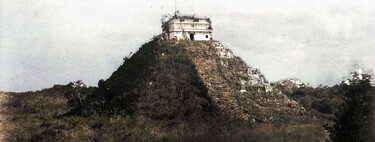The Maya Train has become one of the most emblematic projects of the government of Andrés Manuel López Obrador. The current Mexican president will hand over the belt to Claudia Sheinbaum on October 1, and he will do so without having been able to complete the pharaonic project that aims to open Mexico even more to tourism. The reason is that progress has been halted on a key section of the network after months of controversy.
Now, there are already kilometers of roads built that cross several states and the different teams of archaeologists from Mexico are finishing the conservation and access work to make the Mayan culture more accessible.
MegaprojectWith an initial investment of 150 billion pesos from public-private investment, the Maya Train aims to facilitate access to tourism. There is no discrimination here and the train has stops in areas that have already benefited greatly from tourism, such as the Riviera Maya, but it also aims to facilitate access to towns and ruins that were more difficult to reach.
The goal was to receive 8,000 tourists a day on the Yucatan Peninsula alone and to continue promoting the archaeological sites of Chichén Itzá and Tulum, but also to highlight dozens of other sites such as Campeche, Playa del Carmen, Palenque and Calakmul. In total, the train will cover some 1,500 kilometers through five states and stop at 15 stations.
Discoveries. The majority of the route uses infrastructure already built, but there was a certain percentage that needed to be completed and, in addition, the archaeologists had the task of both supervising the construction so that heritage was not damaged (something that has caused controversy) and investigating to see if they found anything. And boy did they find anything.
Mexico seems to be an inexhaustible source of treasures both visible (you can find some just when you try to expand your ranch) and underground. And during the construction and adaptation of the Mayan Train, INAH researchers came across more than 1.4 million ceramic fragments, more than 50,000 movable and immovable assets such as palaces and structures. It was the largest archaeological treasure found in recent decades in Mexico, since they even found a pyramid 25 meters high on an acropolis another 80 meters long.
Access to heritage. As we mentioned, beyond searching for new Mayan traces, the INAH has the task of improving the Archaeological Zones that coincide with the layout so that it is much easier for tourists to pass through. In a recent statement, Diego Prieto Hernández -general director of the INAH-, has affirmed that, having completed the archaeological rescue work on the seven sections of the train route, they are now concentrating on specific archaeological sites to make the best use of the resources.
They are renovating both trails and signs in different places of the Section 1 of the Mayan Train (which goes from Palenque to Escárcega) and, in these tasks, they have continued recording discoveries, such as a tomb in which polychrome plates were found. The intention of the INAH is to preserve these treasures and exhibit them in existing museums as well as new ones (the History of Yucatan museum which will be inaugurated soon). The idea is to prepare the trails and signs of Section 1 between August and September.
With controversy. In the end, the Mayan Train will be a new way to visit Mexico and places that, perhaps, are not so touristy. Palenque, for example, may not be the first choice for many, but as the INAH highlights, it was “one of the centers where the interpretation and understanding of Mayan writing has been recovered.” However, the controversies seem to be far from over.
And the reason is, precisely, that treasures and archaeological remains of great value have not stopped being discovered throughout the construction process. This is something that has caused a clash between the rush to finish the entire route and the protection of the national heritage, which, as we say, has a large part unexplored.
The environmental impact has been a strong point of conflict, there have been crashes between researchers and The Washington Post published a article called ‘Destroying Mayan treasures to build a tourist train’. The INAH defended ensuring that the country’s heritage is being protected, but the same institution He delivered letters in 2020 and 2021 stating that “an undetermined number of national assets” had been destroyed.
Images | INAH, Mayan Train
At Xataka | The Mayan bones that tell a terrifying story: that of ritual violence against prisoners of war
















Add Comment